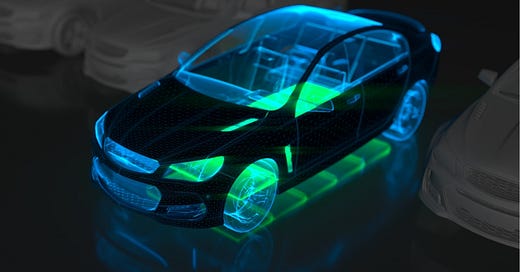Decoding the Surge: Inside China's Growing Dominance of LiDAR Industry
A battle between Hesai and RoboSense, and maybe Seyond?
Table of Contents
Things that Caught Our Attention
LiDAR or Pure Vision Solutions
LiDAR Enhances Reliability of Intelligent Driving
The Rise of Domestic LiDAR in China
Hesai V.S. International Players
Cost Reduction and Efficiency Improvement
Downstream and Future of LiDAR Industry
Things that Caught Our Attention
As the 2024 Spring Festival holiday winds down, many new energy vehicle owners have left their cars behind during the travel rush back home. Due to ferry restrictions to prevent battery fires, numerous NEVs were stranded on the island. (Source: 36Kr)
BYD kicked off the year by releasing the Qin Plus and Destroyer 05 Glory Edition, starting at 79,800 yuan. This prompted price reductions from competitors like Wuling Motors, Hozon Auto, and Changan Qiyuan. (Source: 36Kr) Read this China-specific case study - Manpower over Machines: The Calculated Gamble of BYD.
Insights from Tech Buzz China founder Rui Ma: The challenge of overcapacity in China now impacts entrepreneurial talent, with numerous skilled individuals chasing limited opportunities, prompting a shift towards international markets. The operational approach of Chinese internet companies resembles centrally planned economies, aggressively pursuing market opportunities with a directive strategy. This is exemplified by ByteDance's Capcut app to facilitate video content production and its efforts to nurture content creators, as well as the use of erotica writers by an AI girlfriend app developer to enhance model training.
Introduction
LiDAR stands for Light Detection and Ranging. It's a technology that uses laser light to measure distances and create detailed 3D maps of the Earth's surface. The debate between LiDAR and pure vision solutions (cameras only) has reached a pivotal juncture in the rapidly evolving landscape of intelligent driving technologies. This edition of our newsletter delves deep into the heart of this technological rivalry, offering a comprehensive exploration of LiDAR's role in enhancing the reliability and efficiency of smart driving systems.
In China, LiDAR became a major part of smart driving sensors and started being produced in large amounts in 2022. By 2023, its production greatly increased, marking the first year it was made on a large scale for the Chinese market. As top car companies speed up the roll-out of Navigation on Autopilot (NOA) and strive to be less dependent on high-precision maps, the LiDAR industry is experiencing a surge in both market competition and a rise in product deliveries and user recognition.
We unpack the rise of domestic LiDAR technology in China, a testament to the nation's burgeoning prowess in the global tech arena, and dissect the LiDAR industry chain to provide you with a perspective on the cost dynamics of LiDAR components and the strategic manoeuvres of upstream companies.
We spotlight significant players in the field, Hesai, RoboSense, and Seyond, delving into their financial performance, product performance, competitive positioning against international counterparts, and strategies for cost reduction and efficiency improvement.
The narrative then broadens to the downstream and future prospects of the LiDAR industry, touching upon its role in smart driving, service robots, and vehicle-to-everything communications. Through this edition, we aim to provide a panoramic view of the LiDAR ecosystem, highlighting its challenges, triumphs, and possibilities it holds for the future of intelligent driving and beyond.
Excitingly, we're planning to visit RoboSense and Seyond in mid-May this year. Join our week-long Exclusive Spring 2024 Electric Vehicle Trip in China for an in-depth exploration of leading EV manufacturers, innovative battery producers, LIDAR technology pioneers, and much more, offering unique insights into the future of intelligent driving and automation. Spaces are highly limited - Reserve A Spot Now.
Freya Zhang and Ed Sander, Research Editors
Rui Ma, Consulting Editor
(click on the images above for information on the Tech Buzz China team)
LiDAR or Pure Vision Solutions
In the development of intelligent driving technology, LiDAR remains an essential part that significantly enhances perception accuracy. Currently, there's an ongoing discussion about using LiDAR or just cameras for tech solutions. The central question is whether LiDAR is worth the investment. For example, one LiDAR sensor in the Xpeng P5 car costs almost 9,000 yuan.
The quantity of sensors in vehicles ranges widely. Currently, vehicles now often carry one to two LiDAR sensors, with some models using four or five. The number of LiDARs might increase soon, resembling an arms race, but advancements in visual technology could reduce this need. The trend in the Chinese market is towards more LiDARs, typically needing one front-facing and four corner LiDARs for full coverage. Future vehicles are likely to incorporate even more sensors as technology advances towards full autonomy.
Intelligent driving systems without LiDAR typically use a combination of cameras and millimeter-wave radar. However, this approach is not entirely reliable due to the limitations of millimeter-wave radar: low resolution, not good at dealing with interference, and overly sensitive to metal. This means the system might not see objects clearly and could mistake small metal objects for larger ones. For example, a small coin on the road might appear as large as a manhole cover to the system.
Another method is using only cameras for smart driving systems, like Tesla does. Tesla relies mainly on visual data and considers LiDAR unnecessary. However, relying solely on cameras for self-driving cars is similar to asking people who can't hear or feel to drive, requiring them to depend heavily on their sight, driving experience, and quick reactions.
When Chinese intelligent driving companies try to follow Tesla's approach, they often lag slightly in algorithms and computing power. Despite this, Tesla's approach demonstrates advantages from engineering and commercial perspectives. Meanwhile, domestic automakers and tech firms are testing how to merge and refine data from multiple LiDAR scans to better map environments, but they haven't made major breakthroughs yet.





